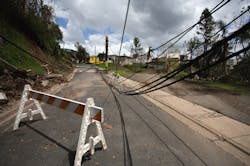Puerto Rico Seeks Developers for Five Industrial Microgrids
Puerto Rico continues to make good on its promise to rebuild with microgrids, issuing five solicitations this week for industrial microgrids that can operate independently from the grid indefinitely.
The solicitations are the island’s latest move to segment its grid after a near total collapse from the September 2017 Hurricane Maria. The storm left the island with the notoriety of experiencing the largest blackout in US history and the second largest in the world, according to the Rhodium Group.
The Puerto Rico Industrial Development Corporation (PRIDCO), a government entity that works to boost the island’s economy, issued the solicitations for five industrial sites.
In keeping with microgrid rules it released in May, the island’s government is particularly interested in industrial microgrids that use renewable energy — likely solar, given Puerto Rico’s sunny position 1,000 miles southeast of Miami.
Bidders are expected to be experienced in microgrids, energy generation and distribution. The ideal candidates can finance, develop, design, construct, operate and manage the industrial microgrids, according to the request for proposals (RFP).
Proposals win points if applicants have the financial capacity to invest in the microgrid, without needing third-party debt financing or other solutions. Innovation and use of local workers also helps boost bidder position. PRIDCO especially wants to see Puerto Rico companies that act as equity providers and undertake design, construction, operations and maintenance.
Microgrids must afford complete grid independence and the RFP says it is “imperative” that the projects provide innovative approaches, capable of supporting indefinite island-mode operation, meeting full energy demand at all points of the year.
The industrial microgrids also must be flexible and scalable, since business operations and tenants may change over time.
The five sites employ a range of industrial processes, including pharmaceutical production, technology, and defense manufacturing. The sites are:
- Aguadilla, which has 1,900 employees working in aerospace, defense, cloud computing and biotechnology. Tenants include Honeywell, Pratt & Whitney and Hewlett Packard. The load is 18.75 MVA/15 MW peak.
- Añasco, where 3,000 employees work in bio-pharma and technology. Tenants include Edwards Lifesciences, J&J Vision Care, Amphenol, Cardinal Health, Techno-Plastics Industries, Integra Neurosciences and GE Industrial. The load is 9.4 MVA/7.5 MW peak.
- Jayuya, home of Baxter Healthcare, a bio-pharma facility with 600 employees. The load is 6.25 MVA/5 MW peak.
- Juana Díaz, where 1,500 employees manufacture medical devices. The tenants are Coopervision, Monsanto and Syngenta. The load is 9.7 MVA/8.7 MW peak.
- Santa Isabel is a site that employs 1,600 people and specializes in aerospace, agricultural research, and logistics. The tenants are United Technologies, AG Reliant Genetics, DHL, Techno-Plastics and Integra Neurosciences. The load is 4.7 MVA/4.2 MW peak.
PRIDCO will accept microgrid proposals to serve all businesses at any site or a sub-set of the operations. But the RFP says applicants must provide justification for not including all tenants.
The RFP has two parts. The first phase, open to all interested parties, seeks conceptual design and qualifications. In the second phase, a short list of applicants will receive greater detail about the sites and be invited to participate in a mandatory visit before submitting full proposals.
PRIDCO will not consider industrial microgrid proposals that use fossil fuel without “some material percentage” of renewables. The projects must combine renewable sources with energy storage systems and a backup generation source.
Applicants must offer two solutions when it comes to renewable energy. The first must comply with the recently issued microgrid rules. The second does not have to comply with the rules but must offer the most efficient resource mix with at least 15 percent from renewables. The second solution also has a price cap of 16 cents/kWh on the microgrid rate.
PRIDCO does not plan to operate the microgrids, so bidders must provide an operation model that includes maintenance of the system. Each facility’s load and resources must be balanced through automated demand response.
Contracts can run a maximum of 10 years. Conceptual designs are due August 24. PRIDCO will select a short list September 14. Proposals are due October 5. PRIDCO hopes to choose winners by October 19.
The five RFPs are available on PRIDCO’s site.
About the Author
Elisa Wood
Editor-in-Chief
Elisa Wood is the editor and founder of EnergyChangemakers.com. She is co-founder and former editor of Microgrid Knowledge.
